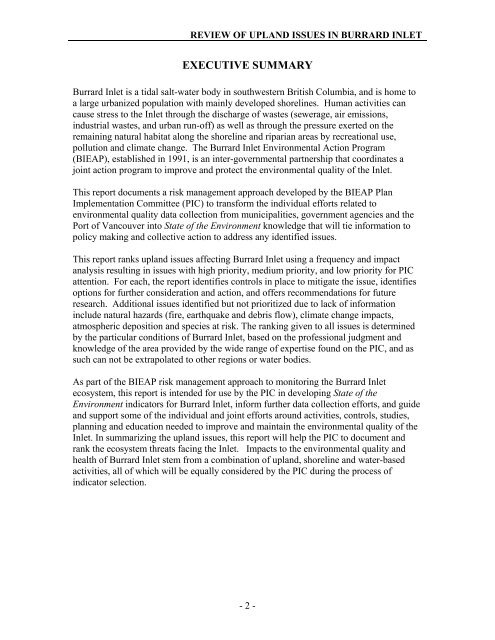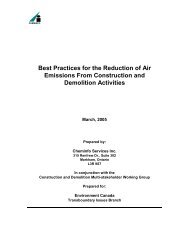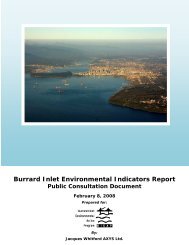A Background Report to Assist Developing Indicators for Burrard
A Background Report to Assist Developing Indicators for Burrard
A Background Report to Assist Developing Indicators for Burrard
Create successful ePaper yourself
Turn your PDF publications into a flip-book with our unique Google optimized e-Paper software.
REVIEW OF UPLAND ISSUES IN BURRARD INLET<br />
EXECUTIVE SUMMARY<br />
<strong>Burrard</strong> Inlet is a tidal salt-water body in southwestern British Columbia, and is home <strong>to</strong><br />
a large urbanized population with mainly developed shorelines. Human activities can<br />
cause stress <strong>to</strong> the Inlet through the discharge of wastes (sewerage, air emissions,<br />
industrial wastes, and urban run-off) as well as through the pressure exerted on the<br />
remaining natural habitat along the shoreline and riparian areas by recreational use,<br />
pollution and climate change. The <strong>Burrard</strong> Inlet Environmental Action Program<br />
(BIEAP), established in 1991, is an inter-governmental partnership that coordinates a<br />
joint action program <strong>to</strong> improve and protect the environmental quality of the Inlet.<br />
This report documents a risk management approach developed by the BIEAP Plan<br />
Implementation Committee (PIC) <strong>to</strong> trans<strong>for</strong>m the individual ef<strong>for</strong>ts related <strong>to</strong><br />
environmental quality data collection from municipalities, government agencies and the<br />
Port of Vancouver in<strong>to</strong> State of the Environment knowledge that will tie in<strong>for</strong>mation <strong>to</strong><br />
policy making and collective action <strong>to</strong> address any identified issues.<br />
This report ranks upland issues affecting <strong>Burrard</strong> Inlet using a frequency and impact<br />
analysis resulting in issues with high priority, medium priority, and low priority <strong>for</strong> PIC<br />
attention. For each, the report identifies controls in place <strong>to</strong> mitigate the issue, identifies<br />
options <strong>for</strong> further consideration and action, and offers recommendations <strong>for</strong> future<br />
research. Additional issues identified but not prioritized due <strong>to</strong> lack of in<strong>for</strong>mation<br />
include natural hazards (fire, earthquake and debris flow), climate change impacts,<br />
atmospheric deposition and species at risk. The ranking given <strong>to</strong> all issues is determined<br />
by the particular conditions of <strong>Burrard</strong> Inlet, based on the professional judgment and<br />
knowledge of the area provided by the wide range of expertise found on the PIC, and as<br />
such can not be extrapolated <strong>to</strong> other regions or water bodies.<br />
As part of the BIEAP risk management approach <strong>to</strong> moni<strong>to</strong>ring the <strong>Burrard</strong> Inlet<br />
ecosystem, this report is intended <strong>for</strong> use by the PIC in developing State of the<br />
Environment indica<strong>to</strong>rs <strong>for</strong> <strong>Burrard</strong> Inlet, in<strong>for</strong>m further data collection ef<strong>for</strong>ts, and guide<br />
and support some of the individual and joint ef<strong>for</strong>ts around activities, controls, studies,<br />
planning and education needed <strong>to</strong> improve and maintain the environmental quality of the<br />
Inlet. In summarizing the upland issues, this report will help the PIC <strong>to</strong> document and<br />
rank the ecosystem threats facing the Inlet. Impacts <strong>to</strong> the environmental quality and<br />
health of <strong>Burrard</strong> Inlet stem from a combination of upland, shoreline and water-based<br />
activities, all of which will be equally considered by the PIC during the process of<br />
indica<strong>to</strong>r selection.<br />
- 2 -
















